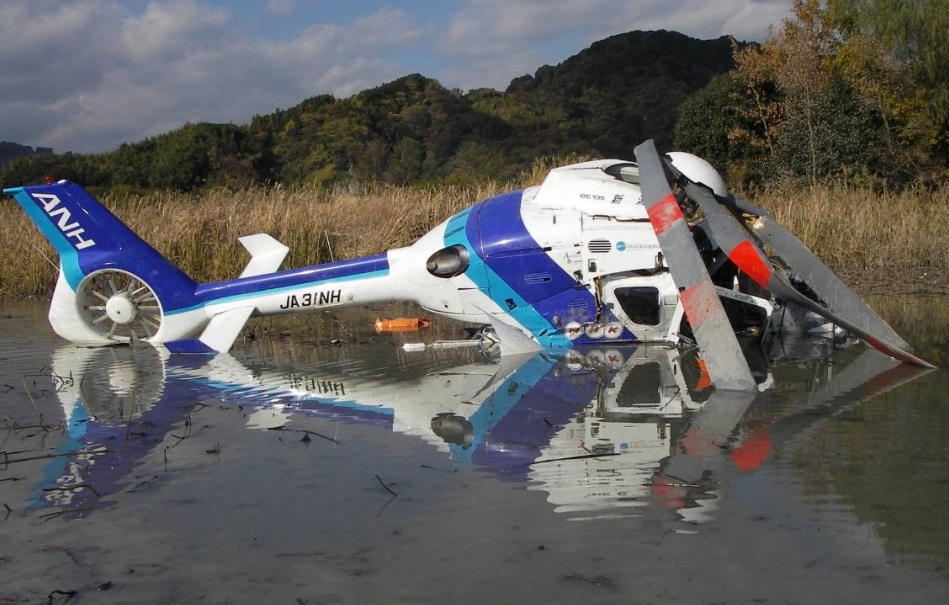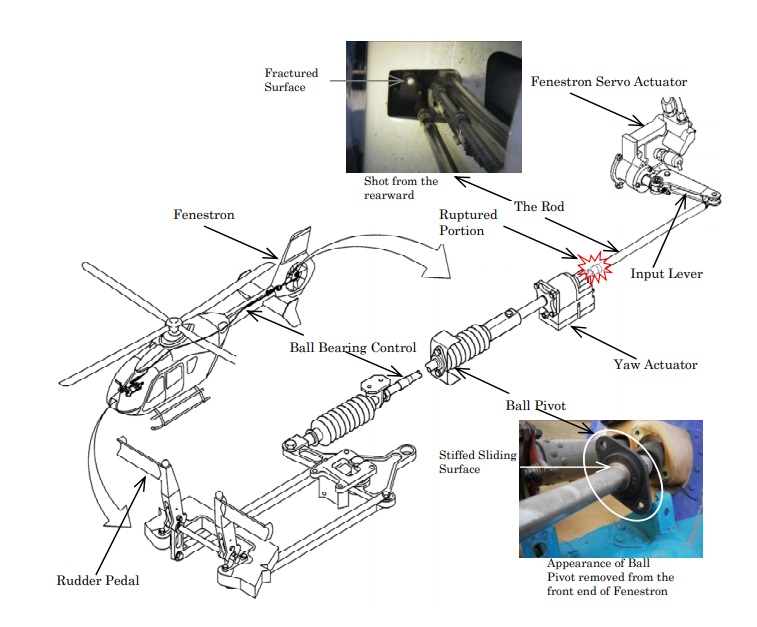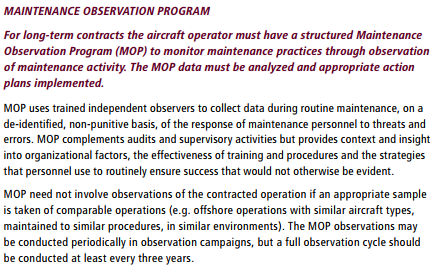Maintenance Misdiagnosis Precursor to EC135T2 TRCF in Japan
On 9 December 2007 Eurocopter EC135T2 JA31NH, operated by All Nippon Helicopter, took off from Tokyo Heliport for a ferry flight to Shizuoka Heliport. The helicopter crashed on approach after a loss of tail rotor (fenestron) control. The pilot died and a mechanic onboard was seriously injured.
Investigators from the Japan Transport Safety Board (JTSB) determined that following the propagation of a fatigue crack, the tail rotor (TR) control rod had ruptured at the threaded connection to the yaw actuator during the flight and this made the tail rotor uncontrollable.
As the helicopter decelerating, the fuselage started to rotate, possibly after power was increased for a go-around, and the aircraft lost height and impacted the ground. The investigators comment in their safety investigation report that:
…it is considered highly probable that the captain did not perform an emergency procedure for the tail rotor failure conditions, as provided in the flight manual. It is considered probable that his failure to perform such an operation reflected the absence of a syllabus for tail rotor failure in the periodic training for the captain.
The investigators note that:
The maintenance manual provides that the periodical inspection of the TR control, including that of the ball pivot, must be performed every 800 flight hours or every three years, whichever occurs first. A periodical check for the Aircraft was performed by the Maintenance Service Company on March 9, 2006, 368 h 25 min in flight time before the occurrence of the accident. But there was no looseness in the threaded area of the Rod. There was no abnormality with the ball pivot, either.
However:
After the accident, it was found that the ball pivot had become stiff in the sliding surface due to corrosion. It is considered highly probable that the unusual feeling in the anti-torque pedal movement, which had been reported by several pilots, was caused by the stiffening of the ball pivot…
The investigation revealed that troubleshooting was performed on 20 October 2007, 45:35 flying hours before the accident, but this:
…was not performed in accordance with the trouble shooting procedure provided in the English written maintenance manual of the aircraft manufacturer. As a result, the inspection of the ball pivot was not performed and its stiffening was not found. In addition, the fact that the joint of the tail rotor control rod and the yaw actuator has a left-handed thread is provided in the English written maintenance manual of the aircraft manufacturer, but it is considered somewhat likely that the mechanic involved in this case, while intending to tighten the joint, actually turned the joint to the opposite direction to loosen it.
The investigators concluded that:
Therefore, it is considered highly probable that the threaded area of the Rod had become loose and the ball pivot had stiff sometime after the periodical inspection performed by the Maintenance Service Company and as a result, a crack created in the threaded area of the Rod.
They went on:
…it is considered highly probable that repetitive bending loads in excess of the fatigue strength had been applied on the Rod due to the loosening of the joint of the Rod and the yaw actuator and the stiffening of the ball pivot as well as a resonance phenomenon following the stiffening. As to the stiffening of the ball pivot, it is considered highly probable that the phenomenon had occurred because red rust created with the corrosion of the contact surface of the inner ring and the outer ring caused volume expansion in the space between the two rings and this restricted the movement of the two rings.
In relation to survivability:
…it is considered highly probable that because the captain had not fastened the shoulder harness, his body bent forward due to the impact at the time of the crash and his heart was damaged as he had his chest hit with the cyclic stick.
Other Safety Resources
Aerossurance has previously written on these associated topics:
- Airworthiness Matters: Next Generation Maintenance Human Factors Over the last 10-15 years, much attention has been focused on maintenance human factors training and reporting & investigating errors. While we could concentrate on simply doing more of these and certainly can find ways to do these things better, perhaps the next generation approach needs to include a much wider range of activities.
- Aircraft Maintenance: Going for Gold? Should we start treating maintenance personnel more like athletes who need to achieve peak performance every day?
- The Power of Safety Leadership
- Leadership and Trust
- Safety Performance Listening and Learning – AEROSPACE March 2017
- How To Develop Your Organisation’s Safety Culture
- James Reason’s 12 Principles of Error Management
- Back to the Future: Error Management
- Critical Maintenance Tasks: EASA Part-M & -145 Change
- C208B Force Landing After Inadequate Maintenance Fault Finding
- Misassembled Anti-Torque Pedals Cause EC135 Accident
- EC130B4 Accident: Incorrect TRDS Bearing Installation
- Loose B-Nut: Accident During Helicopter Maintenance Check Flight
- USAF RC-135V Rivet Joint Oxygen Fire
- Cessna 208 Forced Landing: Engine Failure Due To Re-Assembly Error
- Insecure Pitch Link Fatal R44 Accident
- Bell 429 TR Pitch Change Link Bearing Failure
- B1900D Emergency Landing: Maintenance Standards & Practices
- B747 Landing Gear Failure Due to Omission of Rig Pin During Maintenance
- When Down Is Up: 747 Actuator Installation Incident
- Lost in Translation: Misrigged Main Landing Gear
- Maintenance Human Factors in Finnish F406 Landing Gear Collapse
- Hoist Assembly Errors: SAR Personnel Dropped Into Sea
- Fire After O-Ring Nipped on Installation
- Coking Causes Power Loss: Australian AS350BA
- Crossed Cables: Colgan Air B1900D N240CJ Maintenance Error
- A Lufthansa MD-11F Nose Wheel Detached after Maintenance Error
- Inadequate Maintenance, An Engine Failure and Mishandling: Crash of a USAF WC-130H
- USAF Engine Shop in “Disarray” with a “Method of the Madness”: F-16CM Engine Fire
- Inadequate Maintenance at a USAF Depot Featured in Fatal USMC KC-130T Accident
- AS350B2 Accident After Vibration from Unrecorded Maintenance
- Fatal S-61N Dual Power Loss During Post Maintenance Check Flight
- UPDATE 30 March 2019: Contaminated Oxygen on ‘Air Force One’ Poor standards at a Boeing maintenance facility resulted in contamination of two oxygen systems on a USAF Presidential VC-25 (B747).
- UPDATE 1 April 2019: Tree Top Autorotation for B206L1 After Loose Fuel Line B-Nut Leaks
- UPDATE 12 October 2019: ATR72 VH-FVR Missed Damage: Maintenance Lessons Unclear communications, shift handover & roles and responsibilities, complacency about fatigue and failure to use access equipment all feature in this serious incident.
- UPDATE 24 October 2019: EC135P2+ Loss of NR Control During N2 Adjustment Flight
- UPDATE 2 January 2020: EC130B4 Destroyed After Ice Ingestion – Engine Intake Left Uncovered
- UPDATE 7 February 2020: S-61N Damaged During Take Off When Swashplate Seized Due to Corrosion
- UPDATE 8 April 2020: NTSB Confirms United Airlines Maintenance Error After 12 Years
- UPDATE 9 May 2020: Ungreased Japanese AS332L Tail Rotor Fatally Failed
- UPDATE 5 September 2020: SAR AS365N3 Flying Control Disconnect: BFU Investigation
- UPDATE 9 October: 2020: Latent Engine Defect Downs R44: NR Dropped to Zero During Autorotation
- UPDATE 29 July 2023: Missing Cotter Pin Causes Fatal S-61N Accident
UPDATE 31 May 2019: The Portuguese accident investigation agency, GPIAAF, issued a safety investigation update on a serious in-flight loss of control incident involving Air Astana Embraer ERJ-190 P4-KCJ that occurred on 11 November 2018. The aircraft was landed safely after considerable difficulty, so much so the crew had debated ditching offshore. GPIAAF conformed that incorrect ailerons control cable system installation had occurred in both wings during a maintenance check conducted in Portugal.
GPIAFF note that: “By introducing the modification iaw Service Bulletin 190-57-0038 during the maintenance activities, there was no longer the cable routing and separation around rib 21, making it harder to understand the maintenance instructions, with recognized opportunities for improvement in the maintenance actions interpretation”. They also comment that: “The message “FLT CTRL NO DISPATCH” was generated during the maintenance activities, which in turn originated additional troubleshooting activities by the maintenance service provider, supported by the aircraft manufacturer. These activities, which lasted for 11 days, did not identify the ailerons’ cables reversal, nor was this correlated to the “FLT CTRL NO DISPATCH” message.”
GPIAFF comment “deviations to the internal procedures” occurred within the maintenance organisation that “led to the error not being detected in the various safety barriers designed” in the process. They also note that the error ” was not identified in the aircraft operational checks (flight controls check) by the operator’s crew.”
UPDATE 1 June 2019: Our analysis: ERJ-190 Flying Control Rigging Error
Aerossurance worked with the Flight Safety Foundation (FSF) to create a Maintenance Observation Program (MOP) requirement for their contractible BARSOHO offshore helicopter Safety Performance Requirements to help learning about routine maintenance and then to initiate safety improvements:
Aerossurance can provide practice guidance and specialist support to successfully implement a MOP.
Aerossurance is pleased to be both sponsoring and presenting at a Royal Aeronautical Society (RAeS) Human Factors Group: Engineering seminar Maintenance Error: Are we learning? to be held on 9 May 2019 at Cranfield University.







Recent Comments